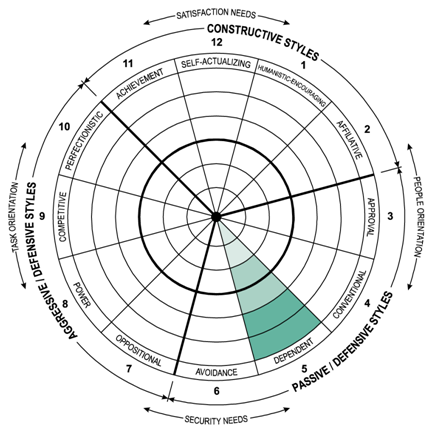In a previous article, we introduced the Human Synergistics Circumplex™, a proven framework to measure, report, discuss and better understand individual and collective human behaviours, and their impact upon business and organisation performance (refer: Catching Smoke: A Proven Framework for Addressing Culture and Leadership).
This latest and final article focuses on one of the Passive/Defensive styles –Dependent: what it’s all about, how when excessive it can hinder your personal effectiveness and the performance of your business/organisation and how to, at a personal and/or workplace culture level, reduce Dependent-oriented thinking and behaviour.

So Just What is the Dependent Style?
Whether we’re looking at it from an individual leadership or broader workplace culture perspective, the Dependent style is characterised by a tendency to feel that our efforts do not count or make a difference, but rather we are subject to external circumstance and/or the actions of others.
Leaders high in the Dependent style may tend to, for example:
- Be more passive than active
- Be overly-concerned with pleasing others and reluctant to take independent action
- Have difficulty making decisions
- Feel a bit helpless rather than masters of their own destiny
- Be easily influenced by others, and
- Be overly-consultative.
Workplace cultures can themselves become Dependent-oriented, with participants feeling expected or implicitly required to, for example:
- Accept goals/decisions without ever questioning them
- Wait for others to decide or act first
- Make decisions primarily on the basis of pleasing others, and
So Why Should I/We Focus on Limiting the Dependent Style?
In both individual leadership and workplace culture contexts, excessive Dependent tendencies can hinder performance. Indeed, research over several decades by Human-Synergistics has consistently shown that leaders and workplaces cultures high in Dependent and other Passive/Defensive styles tend to be significantly less effective than those with predominantly Constructive styles.
From a workplace culture perspective for example, primarily Constructive workplaces:
- are 32% more able to effectively respond to changes in the external environment
- achieve 32% higher quality performance
- demonstrate 28% more effective teamwork
- have a 25% greater commitment to producing a quality result
- include individuals that are 32% more motivated, 26% more satisfied and 25% more likely to stay with the organisation.
At an individual level, leaders high in the Dependent style may be taken advantage of by others, be seen as “wishy washy”, indecisive and lacking the presence and command that may be required, particularly in time of crisis. While they may well be able to build and sustain good relationships with others, it’s likely that their Dependent tendencies will inhibit their effectiveness as a leader from an outcomes/task perspective. Personal satisfaction and wellbeing levels will also tend to be lower in leaders that exhibit high Dependent tendencies over an extended period of time.
It’s important to note that while some leaders may have a strong and long-term orientation toward Dependent thinking and behaviour, for many it can be a temporary issue caused by significant personal or professional changes such as a new job, illness or relationship breakdowns. In these cases, the likely negative impact on personal effectiveness should also be temporary.
At a broader level, those workplaces with strong Dependent characteristics tend to be considerably less effective than those workplaces with Constructive cultural attributes. Employees in Dependent cultures may well be more focused on “staying out of trouble” than optimising performance for example – it’s a case of waiting for others to make the decisions for example, and/or deferring even simple decisions to others for fear of being blamed if things go wrong. In some cases, Dependent cultures may well emerge in workplaces with Power-oriented leaders (“If the boss yells at me when something goes wrong or claims the credit when I do something good, what’s the point of doing anything. I’ll plug away and just do what I’m told”, for example).
While “just doing what your told” can make for an easy existence, it’s not going to drive the best results for the business, and over time it’s not likely to be a satisfying place to work. Those that do want to actively contribute, make a difference and/or further develop their career will readily look for new opportunities.
Limiting Dependent Thinking, Behaviours and Culture
If you think you could improve your effectiveness as a leader by limiting your tendencies toward Dependent thinking and behaviour, try for example:
- Trusting your own judgement – speak up more often, make decisions without over-consulting – reflect and learn on your experiences
- Set some personal goals and work towards achieving them, to build your confidence and belief that your efforts can make a difference
- Take the lead ona key project and/or learn something new
- Reflect on your career and personal life to date and remind yourself of those times your efforts have made a difference – goals achieved, projects successfully completed, relationships developed etc…, and
- Be mindful of your speech patterns and body language – try to get into the habit of carrying yourself confidently, making regular eye contact, and avoid using qualifiers such as “it’s only my opinion, but…” and weakeners such as “only”, “just”, “a little” as in “I’m a little upset…” for example.
To limit Dependent-related expectations at a collective/workplace level, you could try:
- Defining and communicating clear delegations so that people understand the decisions they can/cannot make
- Ensure that shortfalls/mistakes are addressed in a constructive way that does not deter people from contributing or trying again
- Ensure leaders within the business respond to feedback constructively, and as appropriate act on feedback received
- Develop and implement programs that encourage innovation/different ways of thinking, and
- Encourage leaders to not just give their employees all of the answers, but rather ask questions and help them find their own solutions.
This is the final article in our series looking at the what, why and how of the 12 workplace culture and personal leadership style in the Human Synergistics circumplex. If you’ve missed our previous articles on the other styles, be sure to check out our blog – look for the “Focus on Culture and Leadership” series of articles. And of course, call us if you’d like to explore the range of culture and leadership programs we have available to help transform your people, your team and your business/organisation.

